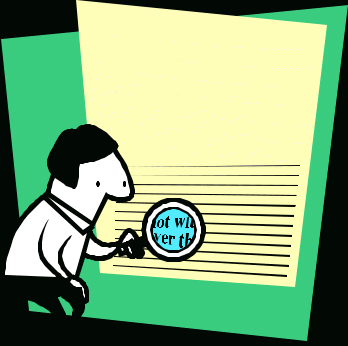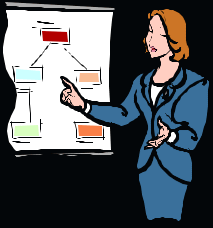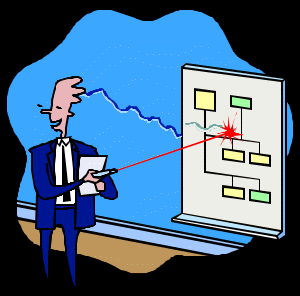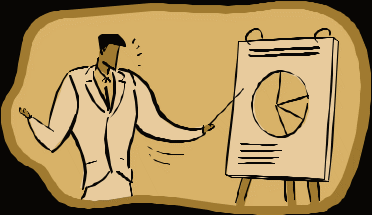Файл: Практикум по основам делового общения на английском языке учебное пособие.doc
ВУЗ: Не указан
Категория: Не указан
Дисциплина: Не указана
Добавлен: 05.02.2024
Просмотров: 109
Скачиваний: 0
ВНИМАНИЕ! Если данный файл нарушает Ваши авторские права, то обязательно сообщите нам.
13. Now you practice writing your own CV, covering and unsolicited letters, and a letter accepting the post.

MAKING PRESENTATIONS
‘The best way to sound like you know what you’re talking about is
to know what you’re talking about.’
Author Unknown
1. Answer the questions.
-
When and why do people give presentations? What do they usually make presentations about? -
Have you ever had to give presentations? Were they in English or in Russian? -
What is the most difficult thing about giving presentations?

2. Which of these suggestions do you agree with?
To make an effective presentation, you should:
-
find out as much as possible about your audience. -
introduce yourself (name, position, company). -
start with a joke. -
outline the structure of your talk. -
vary the tone of your voice. -
refer to your notes as often as possible. -
use clear visual aids. -
summarise your main points.
3. A company boss is presenting his company to potential investors. The presenter does not follow the usual tips for presentations and irritates the investors. Match the tips 1 to 6 that the presenter does not follow with the audience’s reactions a) to f).
| Presentation tips | Audience’s reactions |
|
|
4. Study the information below about the main principles of a successful presentation.
If you want your audience to understand your message, your language must be simple and clear. Use short words and short sentences. In general, talk about concrete facts rather than abstract ideas.
Most presentations are divided into 3 main parts (+ questions):
| 1 | INTRODUCTION | (Questions) |
| 2 | BODY | |
| 3 | CONCLUSION | |
| | Questions | |
As a general rule in communication, repetition is valuable. In presentations, there is a golden rule about repetition:
-
say what you are going to say, -
say it, -
then say what you have just said.
I
 n other words, use the three parts of your presentation to reinforce your message. In the introduction, you tell your audience what your message is going to be. In the body, you tell your audience your real message. In the conclusion, you summarize what your message was.
n other words, use the three parts of your presentation to reinforce your message. In the introduction, you tell your audience what your message is going to be. In the body, you tell your audience your real message. In the conclusion, you summarize what your message was.
Introduction
The introduction is a very important - perhaps the most important - part of your presentation. This is the first impression that your audience has of you. You should use the introduction to:
-
welcome your audience, -
introduce yourself, -
introduce your subject, -
outline the structure of your presentation, -
give instructions about questions.
The following table shows examples of language for each of these functions.
| | Function | Possible language |
| 1. | Welcoming your audience |
|
| 2. | Introducing yourself |
|
| 3. | Introducing your subject |
|
| 4. | Outlining the structure of your presentation |
|
| 5. | Giving instructions about questions |
|
Body
The body is the ‘real’ presentation. If the introduction was well prepared and delivered, you will now be ‘in control’. You will be relaxed and confident.
T
 he body should be well structured, divided up logically, with plenty of carefully spaced visuals.
he body should be well structured, divided up logically, with plenty of carefully spaced visuals.Remember these key points while delivering the body of your presentation:
-
do not hurry -
be enthusiastic -
give time on visuals -
maintain eye contact -
modulate your voice -
look friendly -
keep to your structure -
use your notes -
signpost throughout -
remain polite when dealing with difficult questions
You may find the following phases useful:
-
Finishing one subject...
-
Well, I’ve told you about... -
That’s all I have to say about... -
We’ve looked at... -
So much for...
...and starting another
-
Now we’ll move on to... -
Let me turn now to... -
Next... -
Turning to... -
I’d like now to discuss... -
Let’s look now at...
Giving an example
-
For example,... -
A good example of this is... -
As an illustration,... -
To give you an example,... -
To illustrate this point...
-
Language for using visuals
| Introducing your visual to the audience |
|
| Explaining why the visual is important |
|
Conclusion
Use the conclusion to:
-
sum up, -
(give recommendations if appropriate), -
thank your audience, -
invite questions.
The following table shows examples of language for each of these functions.
| | Function | Possible language |
| 1. | Summing up |
|
| 2. | Giving recommendations |
|
| 3. | Thanking your audience |
|
| 4. | Inviting questions |
|
Handling questions
It’s useful to re-word the question, as you can check that you have understood the question and you can give yourself some time to think of an answer. By asking the question again you also make sure that other people in the audience understand the question.
-
Thank you. So you would like further clarification on our strategy? -
That’s an interesting question. How are we going to get voluntary redundancy? -
Thank you for asking. What is our plan for next year?
After you have answered your question, check that the person who asked you is happy with the answer.
-
Does this answer your question? -
Do you follow what I am saying? -
I hope this explains the situation for you. -
I hope this was what you wanted to hear!
If you don’t know the answer to a question, say you don’t know. It’s better to admit to not knowing something than to guess and maybe get it wrong. You can say something like:
-
That’s an interesting question. I don’t actually know off the top of my head, but I’ll try to get back to you later with an answer. -
I’m afraid I’m unable to answer that at the moment. Perhaps I can get back to you later. -
Good question. I really don’t know! What do you think? -
That’s a very good question. However, we don’t have any figures on that, so I can’t give you an accurate answer. -
Unfortunately, I’m not the best person to answer that.
What can you say if things go wrong?
You think you’ve lost your audience? Rephrase what you have said:
-
Let me just say that in another way. -
Perhaps I can rephrase that. -
Put another way, this means… -
What I mean to say is…
Can’t remember the word?
If it’s a difficult word for you – one that you often forget, or one that you have difficulty pronouncing – you should write it on your index card. Pause briefly, look down at your index card and say the word.
Using your voice
Don’t speak in a flat monotone – this will bore your audience. By varying your speed and tone, you will be able to keep your audience’s attention. Practise emphasizing key words and pause in the right places – usually in between ideas in a sentence. For example:
 "The first strategy involves getting to know our market (pause) and finding out what they want. (pause) Customer surveys (pause) as well as staff training (pause) will help us do this."
"The first strategy involves getting to know our market (pause) and finding out what they want. (pause) Customer surveys (pause) as well as staff training (pause) will help us do this."Don’t forget – if you speak too fast you will lose your audience!
5. Now study the text of the presentation about Tara Fashions.
a) Answer the questions that follow the text.
b) Analyse the structure of the presentation.
c) Note the ‘presentation vocabulary’ the speaker uses and define its function.
Good morning, everyone. Thanks for coming to my presentation. My name’s Marta Rodriguez. I’m Personnel Director of Tara Fashions. I’m going to talk to you today about our company. First, I’ll give you some basic information about Tara Fashions. Then I’ll talk about our overseas stores. After that I’ll outline the strengths of the company. Next I’ll talk about career opportunities with Tara. And finally I’ll mention our future plans. I’ll be pleased to answer any questions at the end of my talk.
Let me start with some basic facts about Tara. The company started in 1978. We are a family-owned business and our head office is in Cordoba, Spain. We sell clothes for men and women, and our customers are mainly fashion-conscious people aged 20 to 35. We have 15 stores in Spain. All of the stores are very profitable.

